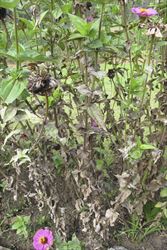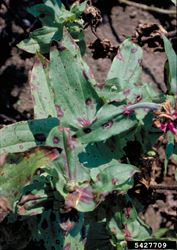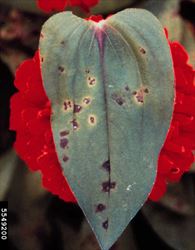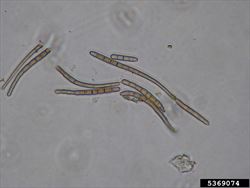Zinnia leaf spots; two similar leaf spots occur: one is caused by the fungus Cercospora, and is called Cercospora leaf spot, the other is caused by the fungus Alternaria, and is called Alternaria blight. CABI prefers the name 'leaf spot of sunflower' for the latter.
Pacific Pests, Pathogens, Weeds & Pesticides - Online edition
Pacific Pests, Pathogens, Weeds & Pesticides
Zinnia leaf spots (532)
Cercospora zinniae and Alternaria zinniae.
Cercospora leaf spot: Asia, Africa, North, South and Central America, the Caribbean, Oceania. It is recorded from American Samoa, Cook Islands, Fiji, Federated States of Micronesia, Guam, Papua New Guinea, Samoa, Solomon Islands, Tonga, Tuvalu, and Vanuatu.
Alternaria blight: Asia, South America (Brazil, Venezuela), the Caribbean (Cuba), Europe (Romania), Oceania. It is recorded from Tonga.
Zinnia (Zinnia elegans); sunflower is a main host for Alternaria zinniae.
Cercospora leaf spot: circular to irregular fungal leaf spots on the upper leaf surface, up to 5 mm across, light grey to white in the centre with reddish to purple border (Photos 1&2). The spots often merge causing the leaves to collapse and die. Spots may also occur on the flowers.
Alternaria blight: The fungal spots are circular at first, rapidly becoming irregular 2 to 10 mm across, reddish-brown with light-grey centres on the upper leaf surface (Photos 3-5). As the spots develop they often join together, dry and the leaves wither and die. The centres of the older spots may fall out. Small spots also occur on the stems and usually remain superficial, but those at the nodes (where the leaves originate) can girdle the stem causing parts above to dieback. Cankers occur at the base of stems. Flowers show small, light-brown spots (1-2 mm across)..
Spread occurs as spores moved in wind-blown rain. Over long distances, possibly between countries, spores of the Alternaria blight are spread with seed. Reports on Cercosproa leaf spot do not mention if it is seedborne or not.
Of the two diseases, Alternaria blight is probably the most severe, although it appears the fungus is less common than Cercospora leaf spot, at least in Pacific island countries. However, zinnias are popular bedding plants worldwide and any damage of leaves concerns grower, and is likely to result in undesirable increased pesticides use.
Look at the shape of the spots: Cercospora spots are round whereas those of Alternaria are more irregularly shaped; however, both have greyish-white centres. Look for stem infections of Alternaria blight, and cankers at soil level. As the symptoms of both these leaf-spotting fungi are similar, look at the spores under a microscope, photograph them, and seek advice from a mycologist (Photos 6&7). Note that an extra difficulty is the fact that both diseases can be present on the same leaf.
BIOSECURITY
Alternaria zinniae is not widely distributed throughout the world, and there are reports that the fungus is seedborne, in which case countries that are vulnerable should restrict uncontrolled entry of seed. Importations of seed should be from reputable commercial sources and certified free from infection.
CULTURAL CONTROL
Cultural control methods for both diseases are similar, except that Cercospora leaf spot may not be seedborne.
Before planting:
- Do not plant next to or down-wind from old plants that are already showing the disease.
- Do not plant a new lot of zinnia (or sunflowers) where the previous crop was diseased.
- Do not use seed taken from diseased plants, or, if using own seed, treat with hot water (51oC for 20 minutes). Reports suggest the Alternaria blight fungus can remain associated with seed for several years.
- Space plants so that air can move between them, drying the foliage quickly, reducing the time available to spores to germinate and infect.
- Do not plant zinnias under shade as leaves will take longer to dry and increase the time for spores to germinate.
During growth:
- Do not water plants from above, otherwise spores will be splashed from infected to healthy leaves and favourable conditions (i.e., leaf wetness and humidity) will be created for spore germination and infection.
After harvest:
- Collect and burn or bury the remains of diseased plants. Reports suggest that the fungus can remain viable in plant trash for 2 years.
- Commercial growers should maintain a rotation of 3 years between crops of zinnia or sunflowers following disease outbreaks. A lesser schedule should be used by home-gardens if planting in small, isolated beds.
RESISTANT VARIETIES
All varieties of Zinnia elegans are moderately or highly susceptible, whereas Zinnia angustifolia is highly resistant to Alternaria zinniae.
CHEMICAL CONTROL
The following protectant fungicides can be used: copper, manozeb and chlorothalonil, or those with systemic activity: strobolins (e.g., azoxystrobin), or sterol biosynthesis inhibitors (e.g., propiconazole).
AUTHOR Grahame Jackson
Information from CABI (2019) Alternaria zinniae (leaf spot of zinnia). Crop Protection Compendium. (https://www.cabi.org/cpc/datasheet/4536); and CABI (2019) Cercospora zinniae. Crop Protection Compendium. (https://www.cabi.org/cpc/datasheet/12298); and Alternaria blight of Zinnia. Missouri Botanic Garden (https://www.missouribotanicalgarden.org/gardens-gardening/your-garden/help-for-the-home-gardener/advice-tips-resources/pests-and-problems/diseases/fungal-spots/alternaria-blight.aspx); and Zinnia-Alternaria blight. Pacific Northwest. Pest Management Handbooks. (https://pnwhandbooks.org/plantdisease/host-disease/zinnia-alternaria-blight); and Zinnia insect pests & diseases (2022) Home & Garden Information Center. Clemson University Cooperative Extension Service. (https://hgic.clemson.edu/factsheet/zinnia-insect-pests-diseases/); and Common leaf diseases of zinnia (1987) Department of Crop Science. University of Illinois Extension. (http://ipm.illinois.edu/diseases/rpds/655.pdf); and Phengsintham P, et al. (2013) Monograph of Cercosporoid fungi from Loas. Current Research in Environmental & Applied Mycology 3(1): 34-158. (https://creamjournal.org/pdf/Cream_3_1_2.pdf). Photo 3 Larry Osborne, Bugwood.org. Photo 4 John Hartman, University of Kentucky, Bugwood.org. Photo 5 Penn State Department of Plant Pathology & Environmental Microbiology Archives, Penn State University, Bugwood.org. Photo 6 Paul Bachi, University of Kentucky Research and Education Center, Bugwood.org. Photo 7. Bruce Watt, University of Maine, Bugwood.org.
Produced with support from the Australian Centre for International Agricultural Research under project HORT/2016/185: Responding to emerging pest and disease threats to horticulture in the Pacific islands, implemented by the University of Queensland, in association with the Pacific Community.










